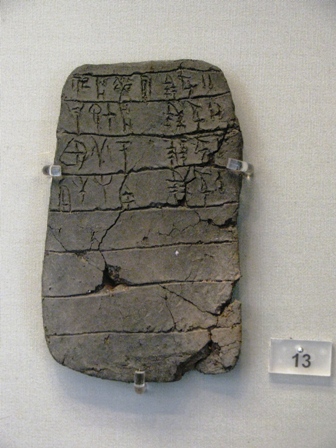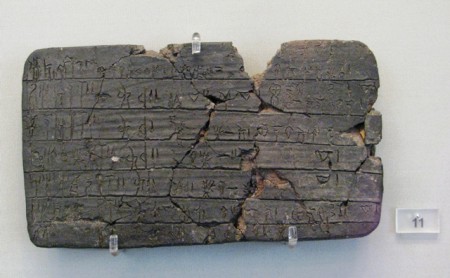I’m not sure if we’ve already flagged the International Symposium on Medicinal and Aromatic Plants, planned for August 16 through 19 in Flores, Peten, Guatemala. As ever, if you’re going, we’d love to hear from you, during the event or afterwards, either way works for us.
Agricultural biodiversity in the Linear B tablets
It was a great thrill during a recent visit to Athens to check out selected Linear B tablets on display at the National Archaeological Museum. I hadn’t seen these things outside books since I was about 12 I think. It was an even greater thrill to realize — or remember — that some deal with agrobiodiversity. Here’s one (Ge 610) that “records quantities of raw materials for perfume manufacture.” It comes from the House of the Sphinxes at Mycenae, which may have belonged to a herbalist.

Unfortunately, I was not able to find any further information online about Ge 610, but I had better luck with Ge 603, one of a set “recording aromatic herbs (cumin, coriander, fennel, sesame, saffron) associated with male (workers) names).”

You can read all about that one in Writing Without Letters:
And it also gets a footnote in another book. Oh what fun one could have with this!
Refocus Afghanistan’s agriculture
We’ve occasionally, and perhaps too timidly, mentioned the futility of attempts to eradicate Papaver somniferum in Afghanistan. The crop is ideally suited to the terrain, and the product lucrative and in short supply globally. Also, illegal, at least in Afghanistan. But not in France, India or Australia. Over at Lawyers, Guns and Money, a group blog, Charli Carpenter makes a well-linked and well-argued case for reframing Afghanistan’s poppy problem (or, perhaps more accurately, the West’s problem with Afghanistan’s poppies) as an opportunity to improve global public health. One thing she doesn’t mention — and why would she? — is that poppies would probably be a lot more sustainable than most of the alternatives, needing less water and less land than, say, wheat or vegetables, and almost certainly displacing less local agricultural biodiversity.
h/t Sam Zeitlin
Nibbles: Sake, Wine, Kew, Climate change, Canada, Banana processing
- To a hammer, everything is a nail; Decanter magazine bemoans loss of sake breweries in Japan.
- One door closes, another one opens; “price winning” Croatian wines.
- Why go to Kew when you can tour with Google streetview?
- Slideshow on genebanks and climate change adaptation in Ethiopia. Wish I could hear the words.
- Canadians! Your heritage crops and breeds need you.
- How best to dry banana slices in Ethiopia.
Nibbles: Micronutrients, Population, Opium, Nixtamalization, Chocolate, Seed swap, Dog domestication, Meeting, Biofuel failure, Mesquite
- “Organic management practices appear to result in elevated levels of grain micronutrient concentration.” By no means the whole story.
- Tom too takes The Economist to task.
- Afghanistan’s opium growers. Damned if you do, damned if you don’t.
- Nixtamalization for the rest of us. More than you could ever want to know. Rye tortillas!
- Chocolate began with leftover beer? Seems unlikely.
- Take the fight to the monster’s lair. Swap seeds in Brussels. h/t Patrick.
- Dogs or dholes? Yeah I didn’t know what they were either.
- There was a workshop on “Seed System and Climate Change” in Bhutan a month ago.
- Big biofuel project in Tanzania bites the dust. And the land they “leased,” what happened to that?
- Ancient grinding holes. Might mesquite be another edible never domesticated?